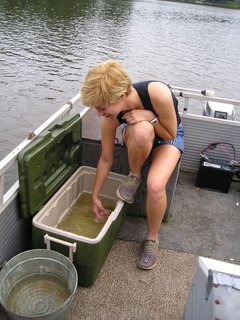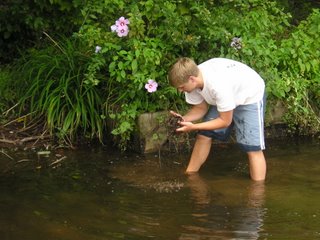Thursday, September 07, 2006
All in a Day's. . . Work?
So these little bugs of the phylum
Myxozoa, class Myxosporea are a common parasite of fish that require an annelid intermediate host (usually an aquatic worm) but now there have been some identified in the guts of ducks. This is something never seen before in ducks, and a few incidents have popped up in California and I think the Carlinas or Virginia, and now a dead duck found in small lake here in Georgia had some in its gut.
What does that me for my educational experinces here at SCWDS? It means I get to go fishing and mucking for worms!
We drove an hour and a half from Athens to this small residetial development where the duck was found.
 Dr. Kevin Keel
Dr. Kevin Keel, my widllife pathology mentor here at SCWDS, is shown skillfully casting a net to gather some fish.

Jason, a wildlife biologist and soon-to-be vet student, also knows how to throw a cast-net.

Laura, a third-year vet student (who probabaly skipped therio lab and an exciting two hours of getting her arm massaged by a cow rectum to go fishing with us) aerated the cooler full of fish so they can get plenty of oxygen. We want to keep them alive up until the moment they are fresh-frozen so that their tissues stay fresh and intact for
necropsy and
histopath.

In addition to collecting fish to look for signs of myxosporea, we also collected some worms (the parasites infect and multiply in the worms before they go on to infect other species) by mucking around the shores and collecting sediment, i.e. mud.

Kevin passed the muck through a sieve and picked out the worms.

The local residents, one of whom captained his boat for our little adventure, are very interested in what's infecting the local fish and possibly duck populations.
So, this is what widlife biologists do? If I had know this when I was four and mucking in the local ponds and even my backyard sanbox for bugs and worms, I could have had my PhD by the time I was nine.